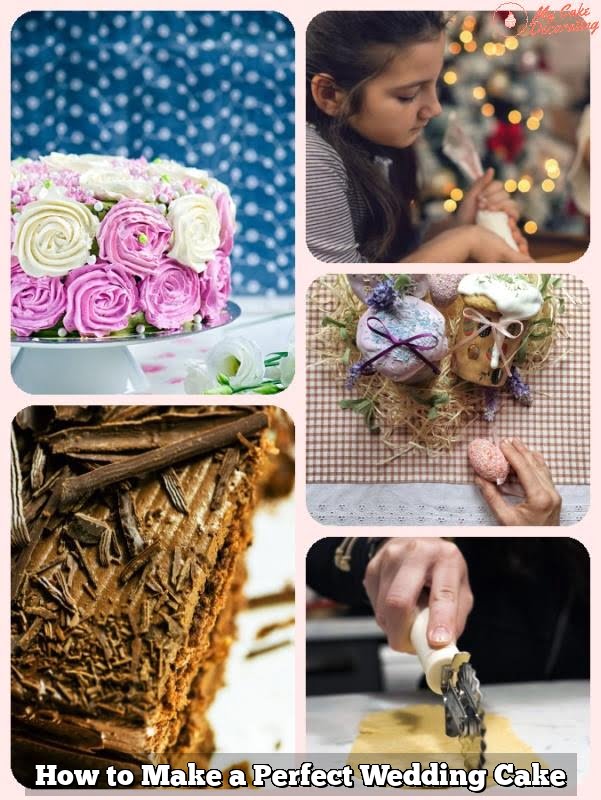A wedding cake is a symbol of joy and celebration, and making one yourself can add an extra touch of love and personalization to the special day. Whether you’re an experienced baker or a first-time cake maker, creating a homemade wedding cake can be a rewarding and memorable experience. In this article, we’ll delve into the essential steps and considerations for making your own wedding cake, from planning and baking to decorating and presentation.
The wedding cake holds a significant place in the ceremony, representing the sweetness and unity of the couple’s union. By taking on the task of making the wedding cake yourself, you can infuse it with even more meaning and sentiment. From selecting the flavors that best represent the couple’s tastes to designing a visually stunning masterpiece, every aspect of the homemade wedding cake reflects thoughtfulness and care.
Throughout this article, we will guide you through each stage of creating a beautiful wedding cake that not only looks impressive but also tastes delicious. Whether you’re looking to save costs or simply want to add a personal touch to the celebration, making your own wedding cake can be a fulfilling endeavor that brings happiness to both you as the creator and to everyone who enjoys it at the reception.
So let’s explore how to make a homemade wedding cake that will be remembered for years to come.
Planning
When it comes to planning a wedding cake, one of the first things to consider is the flavor. The flavor of the cake should reflect the couple’s taste and preferences. Whether it’s a classic vanilla, decadent chocolate, or something more unique like red velvet or lemon, the flavor should be chosen with care. It’s also essential to consider any dietary restrictions or allergies that guests may have when selecting flavors for the tiers.
The size of the wedding cake is another important aspect to plan for. The number of guests will determine how many tiers are needed and what size they should be. A smaller, more intimate wedding may only require a two-tiered cake, while a larger celebration could call for a grand five-tier masterpiece. It’s crucial to ensure that there will be enough cake for all guests without having an excessive amount left over.
The design of the wedding cake is where creativity can truly shine. From sleek and modern to intricate and detailed, there are countless design options to choose from. Consider elements such as floral decoration, metallic accents, or personalized toppers that reflect the couple’s personality and theme of the wedding. It’s important to work closely with the couple to understand their vision and bring it to life in the design of their dream wedding cake.
By carefully planning and selecting the right flavors, size, and design for a wedding cake, couples can ensure that this centerpiece dessert not only looks stunning but also tastes delicious. With attention to detail and consideration for personal preferences and dietary needs, creating a custom-made wedding cake will leave a lasting impression on everyone who attends the celebration.
Ingredients
One of the most important components of a wedding cake is the flour. It forms the structure of the cake and contributes to its texture. Commonly used flours for wedding cakes include all-purpose flour and cake flour, which have different protein contents and will yield different results in terms of tenderness and crumb structure.
Another key ingredient is sugar, which not only sweetens the cake but also contributes to its moisture and tenderness. Granulated sugar is often used in combination with other sweeteners such as brown sugar or confectioners’ sugar to achieve the desired texture and flavor.
Additionally, eggs play a crucial role in binding the ingredients together and adding richness to the cake. When learning how to make a wedding cake, it’s important to consider using high-quality eggs for better flavor and texture.
| Ingredient | Function |
|---|---|
| Flour | Forms structure and contributes to texture |
| Sugar | Sweetens cake and adds moisture |
| Eggs | Binding and adds richness |
Tools and Equipment
When it comes to making a wedding cake, having the right tools and equipment is crucial for ensuring that your cake turns out perfectly. From baking to decorating, having the right supplies can make the process much smoother. Here is a comprehensive guide to the specialized tools and equipment required for cake baking and decorating.
Baking Equipment
To begin with, you will need basic baking equipment such as cake pans in various sizes, mixing bowls, an electric mixer, measuring cups and spoons, and a rubber spatula. Additionally, having a quality oven thermometer will ensure that your cakes bake evenly and at the correct temperature.
Decorating Tools
For decorating the wedding cake, you will need specialized tools such as offset spatulas for frosting the cake, piping bags and tips for creating intricate designs with icing, a turntable for easy access to all sides of the cake while decorating, and a cake leveler for trimming the tops of the tiers to ensure they stack evenly.
Specialized Equipment
There are also some specialized equipment that may be needed depending on the design of the wedding cake. This includes fondant smoothers and rolling pins for working with fondant, sugar shapers for sculpting decorations, and an airbrush kit for adding color or texture to the cake. These tools can help take your wedding cake to the next level in terms of design and visual appeal.
By ensuring that you have all of these tools and equipment on hand when making a wedding cake, you can feel confident in your ability to create a stunning masterpiece that will impress both the couple and their guests.
Baking
Once you have gathered your ingredients, it is time to follow a tried-and-true recipe for each tier of the wedding cake. Whether you choose to make a classic white cake, decadent chocolate cake, or another flavor that holds personal significance for the couple, it is important to carefully measure and mix the ingredients according to the recipe’s instructions.
Pay close attention to details such as mixing times and oven temperatures to ensure that each tier bakes evenly and comes out perfectly every time.
In addition to following a precise recipe, it is important to consider the size and shape of each tier when baking a wedding cake. Larger tiers may require longer baking times at slightly lower temperatures to prevent over-browning or drying out, while smaller tiers may bake more quickly at higher temperatures.
By taking these factors into account and using quality ingredients and precise measurements, you can ensure that each tier of the wedding cake bakes up beautifully so that it can be stacked and decorated with ease.
| Ingredient | Importance |
|---|---|
| High-quality flour | Provides structure |
| Eggs | Contributes moisture and richness |
| Baking powder/soda | Helps in rising |
Assembling
Once the cake layers are ready, it’s time to focus on stacking and filling them. One of the most important aspects of assembling a wedding cake is ensuring that each tier is level and evenly stacked. Using a cake leveler or a long serrated knife, carefully trim the top of each layer to create an even surface for stacking. When applying the filling between layers, it’s essential to spread it evenly to maintain consistency throughout the entire cake.
After successfully stacking and filling the tiers, securing them in place is vital to prevent any mishaps during transportation or display at the wedding reception. The use of dowels or support rods is highly recommended to provide structural support for each tier. These supports should be inserted into the base tier before adding subsequent tiers. This will help distribute the weight of the upper tiers and prevent any potential movement or collapse of the cake.
Assembling a wedding cake requires patience and precision, but with careful attention to detail and following these tips and techniques, you can ensure that your masterpiece stands tall and stunning on the big day.
Decorating
- Frosting: The type of frosting used can greatly impact the overall look and taste of the wedding cake. Some popular options for frosting include buttercream, fondant, and royal icing. The choice of frosting can depend on the design and theme of the wedding.
For a rustic or vintage wedding theme, buttercream frosting with textured swirls or ruffles can create a charming look. On the other hand, fondant allows for a smooth and polished finish that is perfect for modern or elegant wedding designs. - Piping: Piping techniques can add intricate details and decorative elements to the wedding cake. Using a piping bag with different tips, such as round, star, or petal tips, allows for creating patterns like lace, flowers, or geometric designs on the cake tiers. Additionally, piping small dots or beads along the edges of each tier can add a touch of elegance to the overall appearance.
- Embellishments: Adding embellishments to the wedding cake can enhance its beauty and tie in with the wedding theme. Edible decorations such as fresh flowers, edible pearls, metallic accents, or sugar crystals can be strategically placed on the cake to create a sophisticated and personalized look.
By understanding these creative ideas and methods for decorating a wedding cake, including frosting options, piping techniques, and embellishments, you can elevate your homemade creation into a masterpiece that will impress all guests at the wedding reception.
Presentation
Once the wedding cake has been baked, assembled, and decorated, it is time to focus on its presentation at the reception. This step is crucial as it adds the final touches to make the wedding cake a beautiful centerpiece that will wow the guests. Here are some tips on how to display and present the wedding cake at the reception:
- Cake Stand: Select a sturdy and visually appealing cake stand that complements the design of the wedding cake. Consider using a tiered cake stand for multi-tiered cakes.
- Lighting: Choose strategic lighting to highlight the wedding cake and make it stand out in the room. LED lights or candles can create a warm and inviting glow around the cake.
- Decorative Accents: Add decorative accents around the base of the cake stand, such as flowers, greenery, or fabric that matches the color scheme of the wedding.
- Signage: Consider adding a personalized sign or monogram to showcase the couple’s initials or a meaningful message that adds a personal touch to the presentation.
- Cutting Ceremony: Coordinate with the catering staff or emcee to plan a special moment for when the couple cuts into their wedding cake. This can be a memorable photo opportunity for both them and their guests.
By following these guidelines, you can ensure that your homemade wedding cake not only tastes delicious but also serves as a stunning centerpiece at the reception. The careful presentation of the cake will leave a lasting impression on all in attendance and further emphasize how special this homemade creation truly is.
Conclusion
Making a wedding cake from scratch can be a daunting task, but the sense of accomplishment and satisfaction in creating something beautiful and meaningful for such a special occasion is truly unparalleled. By following the steps outlined in this guide, you can create a homemade wedding cake that will not only impress the couple and their guests but also fill you with pride.
The joy that comes from seeing the happy faces of the newlyweds as they cut into the cake you made for them is truly priceless.
As you embark on the journey of making a wedding cake, remember that each step – from planning and selecting flavors to baking, assembling, decorating, and presenting – is an opportunity to pour your love and dedication into this significant symbol of love and commitment. With careful attention to detail and creative flair, you can create a stunning centerpiece for the wedding celebration that reflects the unique personality and style of the couple.
As you put your heart into every aspect of making the wedding cake, your efforts will be appreciated and remembered by all who partake in this sweet creation.
In conclusion, making a wedding cake by yourself is not just about saving money or showcasing your baking skills; it’s about adding a personal touch to an important day in someone’s life. The time, effort, and care that go into creating a homemade wedding cake are all worth it when you see how much joy it brings to the couple and their guests.
So don’t be afraid to take on this challenge – with patience, passion, and creativity, you can make a wedding cake that will be remembered fondly for years to come.
Frequently Asked Questions
How Many Days Before a Wedding Can You Make the Cake?
The number of days before a wedding that you can make the cake depends on the type of cake you’re making. Generally, for a traditional tiered cake, it’s recommended to start about 2-3 days before the wedding to ensure freshness.
What Do You Need to Make Your Own Wedding Cake?
To make your own wedding cake, you will need basic baking ingredients like flour, sugar, butter, eggs, and flavorings. You’ll also need cake pans, a stand mixer or hand mixer, and tools for decorating such as piping bags and offset spatulas.
Is It Worth Making Your Own Wedding Cake?
Whether it’s worth making your own wedding cake depends on your baking skills, time availability, and stress tolerance. If you enjoy baking and have the time to dedicate to it, making your own wedding cake can be a meaningful and cost-effective option.

Welcome to my blog about home and family. This blog is a place where I will share my thoughts, ideas, and experiences related to these important topics. I am a stay-at-home mom with two young children. I hope you enjoy reading it! and may find some helpful tips and ideas that will make your home and family life even better!





